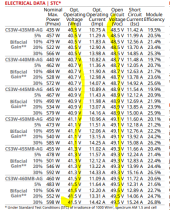I got a dark roof that is not going to reflect and like back up to the bottom d a bifacial panel, but because the cost of bifacial panels is better than monofacial panel, I’m considering using them and want to make sure there is not some downside I’m overlooking.
For example, does the lack of white vinyl backing on a bifacial pane mean that some from-side irradiance that otherwise would be reflected back by the white vinyl and generates some power under STC will instead be wasted by passing through a bifacial panel where it will be wasted heating a non-reflective roof?
Can the power output under STC of a bifacial panel mounted on a dark non-reflective roof be lower than datasheet specifications?
Are there any other reasons to shy away from the use of bifacial panels mounted on a non-reflective roof I am overlooking?
For example, does the lack of white vinyl backing on a bifacial pane mean that some from-side irradiance that otherwise would be reflected back by the white vinyl and generates some power under STC will instead be wasted by passing through a bifacial panel where it will be wasted heating a non-reflective roof?
Can the power output under STC of a bifacial panel mounted on a dark non-reflective roof be lower than datasheet specifications?
Are there any other reasons to shy away from the use of bifacial panels mounted on a non-reflective roof I am overlooking?




